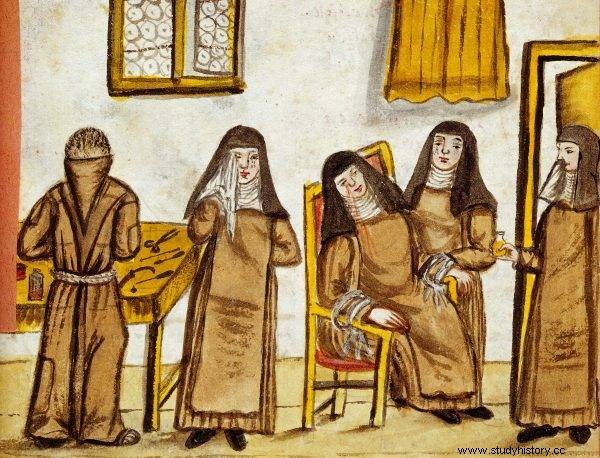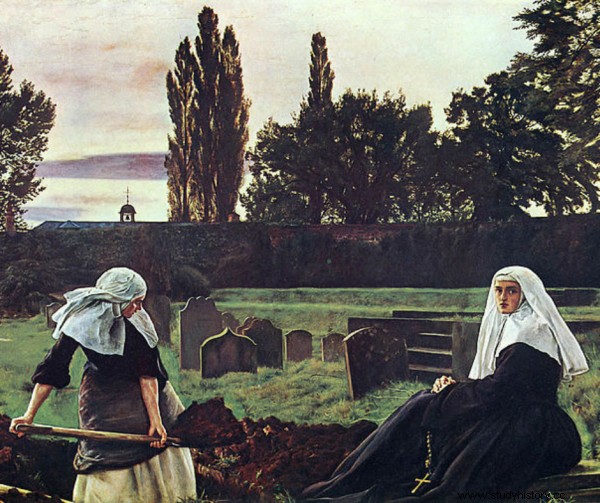For medieval women, wearing a religious habit was often the only sensible alternative to getting married, although, of course, not all of them decided to do so of their own free will. What was the life of those who - driven by faith or compulsion - allowed to lock themselves up behind the monastery wall?
Medieval monasteries were built according to a certain pattern. A high wall surrounded a large area of land, including gardens, orchards, a fish pond and wooden farm buildings - stables, granary, bakery, brewery, mill and dovecote - centered around the main buildings with courtyards:the church and monastery, infirmary, refectory (dining room) with with a kitchen, the dormitory where the nuns slept, the chapter house where their meetings took place, the abbey's quarters, and sometimes also an inn for guests.
Monastic hierarchy
(...) The community of nuns was led by the abbess - the abbess or, in smaller congregations, the Mother Superior - whose primary task was to maintain discipline in the monastery. (...) It was a lifetime position, unless the appointed person voluntarily resigned or was removed for incompetence or inappropriate behavior.
The supervisors' subordinates, responsible for everyday affairs, managing the monastic life, keeping books and the work of servants, were helpers, selected from among the elderly members of the community. At the top of the monastic hierarchy were the prioress, her deputy and the treasurer while various specific functions fell to the helpers.
Kantorka led the singing during the services. The sacristan took care of liturgical vestments, altar cloths and reliquaries; she bought wax, tallow and wicks, and hired candle makers. One of the nuns repaired chairs, tables, clothes and dishes, supervised the setting of the tables, and kept the wash basins clean.

What was happening behind the closed doors of monasteries did not always reach the outside world.
The almighty woman dealt with donations. The maid of honor ordered sewing, mending and cleaning of clothes and bedding. The monastic steward cared for food and often ran a monastery farm. The cook supervised the cooking of the dishes under the supervision of the dispenser. The nurse cared for the sick. The head of the novitiate supervised and instructed the novices.
(...) The female orders used the services of at least one chaplain accommodated outside the convent, who celebrated masses and confessed nuns. Sometimes he also managed the financial affairs of the order (...).
Strictly defined schedule
The daily schedule of activities in all Benedictine monasteries, male and female, was strictly fixed, with times dedicated to prayer, work and study. Prayers, held every three hours, set the tone and rhythm of the passing days.
The nuns got up at six or seven, depending on the season, for the prime, which, like the other liturgies of the hours, consisted of a series of psalms, short prayers and the so-called responses.

One of the most famous medieval nuns was Hildegard of Bingen.
After a breakfast of bread washed down with wine, beer or water, the community gathered in the chapter house in the eastern wing of the monastery for a meeting where various issues were discussed regarding rent and lease, the sale of land or timber, and subsidies. Approved documents were marked with the seal of the Order. Then ethical and spiritual issues were discussed. The guilty women confessed to various misdeeds or listened to accusations and were given penance or corporal punishment, often enforced with a stick (...).
At noon, the nuns went in a group to the refectory, where one of them read passages from the Holy Scriptures or the works of the Fathers of the Church, while the others nourished themselves, eating vegetables, bread, fruit, and sometimes fish. Meat was served only in the infirmary, which, however, was a source of some abuse.
(...) The hours after lunch were devoted to work. "Vanishing is the enemy of the soul," wrote Saint Benedict, recommending six hours of manual labor a day, formerly performed in the field, with a spinning wheel and looms, or devoted to household chores. In the 6th century, Queen Radegunda, a nun of the Holy Cross Convent in Poitiers, was taking away garbage, bringing water and wood, burning in the stove, sweeping, cooking, cleaning and washing dishes.
However, aristocrats of the later medieval period refrained from such obligations. Almost all female monasteries employed cooks, maids, and laborers or laborers, and large congregations usually also had a butler, brewer, baker, malt producer, milkman, housekeeper, and laundress, with some nuns also having personal maids . The Benedictine work of nuns was therefore limited to such activities as embroidering (...).
At the end of the working day, the nuns ate a supper, which was also accompanied by reading the scriptures aloud, and after the full service service, they went to the dormitory, where they slept fully clothed in a common room, in small compartments separated by low partitions.
Theory versus practice
(...) Benedictine practices were based on two basic principles:common life and poverty. Everything had to be done together, including prayer, work, meals, and sleep. The nuns were not allowed to possess any personal belongings, money, furniture or jewels.
The clothes were taken from the common warehouse belonging to the congregation, and when a new garment was released, the old one had to be returned. In practice, the longing for a little privacy and the desire to have something of your own continued to make itself felt. Bishops' visits were associated with discovering the constant violations of the principle of community and poverty (...).
Another aspect of female monasticism, quite difficult to enforce, was a life of isolation, considered particularly important because of women's notorious susceptibility to temptation. It was inappropriate to contact the outside world and it was at risk of a scandal.
Every now and then, ordinances and reforms were made to enforce strict confinement, but such recommendations often clashed with the need to provide an income for the religious community and the provision of monasteries, as well as the desire of nuns to maintain family and friendly ties.
(...) Despite the ordinances and orders of the bishops, nuns found many excuses to occasionally leave the monastery. In general, business trips to the city or to markets were allowed to purchase products that could not be grown or produced on the monastery farm - such as salt and fish, pots, nails, soap, parchment, and spices.

The life of nuns in monasteries was filled with hard work? Not really…
(…) The outside world also penetrated into the monastery. Admission to the dormitory, refectory, infirmary, chapter house and the cloister was theoretically forbidden to persons outside the monastery walls, and any stay had to be limited to daylight hours and follow the rules for interviews.
Such rules were more difficult to enforce than letter requirements. (...) Friends and relatives of the nuns were not allowed to enter the convent building, and servants and other lay people were not allowed to stay overnight in the dormitory.
Violations of the vow of chastity in female orders , mostly reported by bellicose and malicious Protestant writers, did occur and were recorded in bishops' visitation documents, but in fact such misdemeanors were surprisingly rare.
Source:
The above text is an excerpt from the book by Frances and Joseph Gies "The Life of a Medieval Woman" , published by the Znak Horyzont publishing house.
The title, lead, illustrations with captions, bolds and subtitles come from the editorial office. The text has undergone some basic editing to introduce more frequent paragraph breaks.
